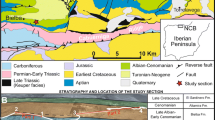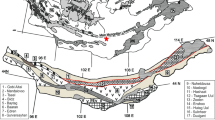Abstract
Outcrops of Upper Triassic carbonates of shallow-marine character are rare in Mexico. Another locality, next to the Antimonio depositional system (ADS) in Sonora, is found on the Vizcaíno terrane (Baja California Sur), near the village of San Hipólito. The outcropping formation is named after the nearby village and represents an arc-ophiolite assemblage. The formation comprises a limestone breccia, which includes re-worked Upper Norian shallow-water limestone. In addition, questionable lowermost Rhaetian radiolarians have been found in some clasts of the breccia. Accordingly, the breccia member possibly deposited during the uppermost Norian–lowermost Rhaetian. Based on their preservation, 43 clasts representative of the main lithologies have been sampled along a 550-m-long outcrop surface. Some authors proposed the Vizcaíno to have been in close relation to the ADS in north-western Sonora. It has been proposed that the Antimonio served as the source of the limestone clasts contained within the San Hipólito Formation. Petrographic analysis and micropaleontologic evidences, however, indicate a more distal relationship between the two systems. Furthermore, the microfacies proposed by the hierarchical clustering include some rather poorly constraint facies. This could be explained by the facts that (a) the samples have derived from clasts that not necessarily represent a stratigraphic succession and (b) multiple systems could have contributed to the assemblage.








Similar content being viewed by others
References
Baccelle L, Bosellini A (1965) Diagrammi per la stima visiva della composizione percentuale nelle rocce sedimentarie. Ann Univ Ferrara 1:59–62
Boschman LM, van Hinsbergen DJJ, Kimbrough DL, Langereis CG, Spakman W (2018) The dynamic history of 220 million years of subduction below Mexico: a correlation between slab geometry and overriding plate deformation based on geology, paleomagnetism, and seismic tomography. Geochem Geophys Geosyst 19:4649–4672. https://doi.org/10.1029/2018gc007739
Busby C (2004) Continental growth at convergent margins facing large ocean basins: a case study from Mesozoic convergent-margin basins of Baja California, Mexico. Tectonophysics 392:241–277. https://doi.org/10.1016/j.tecto.2004.04.017
Campa MF, Coney PJ (1983) Tectono-stratigraphic terranes and mineral resource distributions in Mexico. Can J Earth Sci 20:1040–1051. https://doi.org/10.1139/e83-094
Campos-Enríquez JO, Hernández-Quintero E, Lozada-Zumaeta M (2005) The crust at northwestern Mexico interpreted from Magsat anomalies: implications for the existence of the Mojave-Sonora megashear. Geol Soc Am Spec Pap 393:199–208. https://doi.org/10.1130/0-8137-2393-0.199
Caruthers AH, Stanley GD Jr (2008) Systematic analysis of Upper Triassic silicified scleractinian corals from Wrangellia and the Alexander Terrane, Alaska and British Columbia. J Paleontol 82:470–491
Centeno-García E (2017) Mesozoic tectono-magmatic evolution of Mexico: an overview. Ore Geol Rev 3:1035–1052. https://doi.org/10.1016/j.oregeorev.2016.10.010
Centeno-García E, Silva-Romo G (1997) Petrogenesis and tectonic evolution of central Mexico during Triassic–Jurassic time Revista Mexicana de Ciencias Geológicas 14:244–260
Chablais J (2010) Sedimentology and biostratigraphy of the Upper Triassic atoll-type carbonates of the Sambosan Accretionary Complex (panthalassan domain; Japan)
Coe AL, Bosence DWJ, Church KD, Flint SS, Howell JA, Wilson RCL (2003) The Sedimentary record of sea-level change. Cambridge University Press and the Open University, Cambridge. https://doi.org/10.2277/0521831113
Coney PJ (1983) Un modelo tectónico de México y sus relaciones con América del Norte América del Sur y el Caribe. Revista del Instituto Mexicano del Petróleo 15:6–15
Couch RW et al (1991) Gravity anomalies and crustal structure of the Gulf and Peninsular Province of the Californias. AAPG Memoir 47:24–45
Einsele G (2000) Sedimentary basins; evolution, facies, and sediment budget. Springer, Berlin
Finch JW, Abbott PL (1977) Petrology of a Triassic marine section, Vizcaino Peninsula, Baja California Sur, Mexico. Sed Geol 19:253–273
González-León C (1989) Evolucion de terrenos mesozoicos en el noroeste de Mexico. Boletín del Departamento de Geología de la Universidad de Sonora 6:39–54
González-León CM (1997) Stratigraphy and paleogeographic setting of the Antimonio Formation, Sonora, Mexico. In: M. G-LC, Stanley JGD (eds) US-Mexico cooperative research: international workshop on the geology of Sonora, January 6–10, 1997. Hermosillo, Sonora, México: Memoir, pp 136–148
González-León CM, Taylor DG, Stanley J, George D (1996) The Antimonio Formation in Sonora, Mexico, and the Triassic–Jurassic boundary. Can J Earth Sci 33:418–428. https://doi.org/10.1139/e96-031
Goodwin DH (1997) The importance of paleoecology in assessing paleogeographic relationships of the Antimonio Formation. In: US-Mexico cooperative research. International workshop on the geology of Sonora Memoir. Univ Nac Autón México, Inst Geol, Estación Regional del Noroeste, Publ Ocas. pp 36–38
Hagstrum JT, McWilliams M, Howell DG, Grommé S (1985) Mesozoic paleomagnetism and northward translation of the Baja California Peninsula GSA. Bulletin 96:1077–1090. https://doi.org/10.1130/0016-7606(1985)96%3c1077:Mpanto%3e2.0.Co;2
Hagstrum JT, Lopez Martinez M, York D (1993) Paleomagnetic and (super 40) Mg/(super 39) Ar evidence for remagnetization of Mesozoic oceanic rocks on the Vizcaino Peninsula, Baja California Sur, Mexico. Geophysi Res Lett 20:1831–1834
Haq BU (2018) Triassic eustatic variations reexamined. GSA Today. https://doi.org/10.1130/GSATG381A.1
Haq BU, Hardenbol J, Vail PR (1988) Mesozoic and Cenozoic chronostratigraphy and cycles of sea-level change. https://doi.org/10.2110/pec.88.01.0071
Heerwagen E, Martini R (2018) The Antimonio ramp in Sonora. Mexico Facies. https://doi.org/10.1007/s10347-018-0519-2
Hillhouse JW, Gromme CS (1980) Paleomagnetism of Triassic red beds and basalt in the Chulitna Terrane, south-central Alaska.
Howell DG (1985) Tectonostratigraphic terranes of the Circum-Pacific region. In: Circum-Pacific Council for Energy and Mineral Resources, Earth Science Series, Number 1. pp 3–30
Irving E (1972) The ancient oceanic lithosphere—identification within the present continents, statement of the problem. In: Publications of the Earth Physics Branch, vol 42. pp 47–47
Kaminski MA, Setoyama E, Cetean CG (2008) Revised stratigraphic ranges and the Phanerozoic diversity of agglutinated foraminiferal genera. In: Grzybowski Foundation Special Publication, vol 13. pp 79–106
Kimbrough DL (1985) Tectonostratigraphic Terranes of the Circum-Pacific region. In: Howell DG (ed) Circum-Pacific council for energy and mineral resources. pp 285–298
Kimbrough DL, Moore TE (2003) Ophiolite and volcanic arc assemblages on the Vizcaino Peninsula and Cedros Island, Baja California Sur, México: Mesozoic forearc lithosphere of the Cordilleran magmatic arc. Geol Soc Am Spec Pap 374:43–71
Lindström S, Irmis RB, Whiteside JH, Smith ND, Nesbitt ND, Turner AH (2016) Palynology of the upper Chinle Formation in northern New Mexico, USA: Implications for biostratigraphy and terrestrial ecosystem change during the Late Triassic (Norian-Rhaetian). Rev Palaeobot Palynol 225:106–131. https://doi.org/10.1016/j.revpalbo.2015.11.006
McClelland WC, Gehrels GE, Saleeby JB (1992) Upper Jurassic-Lower Cretaceous basinal strata along the Cordilleran Margin: implications for the accretionary history of the Alexander-Wrangellia-Peninsular Terrane. Tectonics 11:823–835
Mina-Uhink FU (1957) Bosquejo geológico del Territorio Sur de la Baja California. Bol Asoc Mex Geol Petrol 9:139–269
Morán Zenteno DJ, Wilson JL, Sanchez-Barreda L (1994) The geology of the Mexican Republic. In: AAPG studies in geology, vol 39, 1 edn. American Association of Petroleum Geologists, Tulsa
Orchard MJ, Whalen PA, Carter ES, Taylor HJ (2007) Latest Triassic conodonts and radiolarian-bearing successions in Baja California Sur New Mexico Museum of Natural History and Science. Bulletin 41:355–365
Ortega-Rivera A (2003) Geochronological constraints on the tectonic history of the Peninsular Ranges Batholith of Alta and Baja California: Tectonic implications for western México. Geol Soc Am Spec Pap 374:297–335
Parrish JT (1993) Climate of the supercontinent Pangea. J Geol 101:215–233. https://doi.org/10.1086/648217
Pessagno EAJ, Finch W, Abbott PL (1979) Upper Triassic radiolaria from the San Hipolito Formation, Baja California. Micropaleontology 25:160–197
Roniewicz E, Stanley GD Jr (2013) Upper Triassic corals from Nevada, western North America, and the implications for paleoecology and paleogeography. Journal of Paleontology 87:934–964
Schweickert RA (1978) Triassic and Jurassic paleogeography of the Sierra Nevada and adjacent regions, California and western Nevada Pacific coast paleogeography symposium. pp 361–384
Sedlock RL (1988) Tectonic setting of blueschist and island-arc terranes of west-central Baja California, Mexico. Geology 16:623–626
Sedlock RL (2003) Four phases of Mesozoic deformation in the Sierra de San Andres Ophiolite, Vizcaíno Peninsula, west-central Baja California, México. Geol Soc Am Spec Pap 374:73–92
Whalen PA, Carter ES (2002) Pliensbachian (Lower Jurassic) Radiolaria from Baja California Sur, Mexico. Micropaleontology 48:97–151
Acknowledgments
The authors thank Carlos M. Gonález-León (Univsersidad Nacional Autónoma de México, UNAM), and Jaime Morals Villavicencio (El Vizcaino Biosphere Reserve) for their substantial help in organizing and executing the field campaign. Also, we would like to thank Carlos M. González-León (UNAM) and George Stanley Jr. (University of Montana) for discussions on the samples and their geodynamic implications. Our thanks extend to Luka Gale (Geological Survey of Slovenia) and Sylvain Rigaud (Nanyang Technological University) for their help in determination of the found foraminifers. We thank the reviewers for their comments on the manuscript that helped to improve it substantially. The field work was supported by the Swiss National Science Foundation (Grant # 200020-137661 to R. Martini).
Author information
Authors and Affiliations
Corresponding author
Rights and permissions
About this article
Cite this article
Heerwagen, E., Martini, R. The Vizcaíno terrane: another occurrence of Upper Triassic shallow-marine carbonates in Mexico. Facies 66, 8 (2020). https://doi.org/10.1007/s10347-019-0592-1
Received:
Accepted:
Published:
DOI: https://doi.org/10.1007/s10347-019-0592-1




